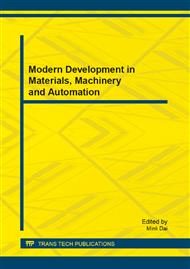p.3
p.9
p.15
p.23
p.29
p.35
p.45
p.53
New Construction Materials Based on Automobile Construction Sludge
Abstract:
This paper is devoted to the development of valuable new construction materials based on various ecologically burdensome galvanic wastes, namely industrial sludge from the RENAULT plant and metal cleaning glass waste. The only natural component used is local clay. Both of the wastes need significant financial investment and efforts for neutralization and subsequent disposal while they can be recycled into glass-ceramics or red ceramics (tiles, bricks, blocks, etc.). Mechanical properties of the ceramics of various compositions are as follows: flexion resistances are 4.8-9.2, 7.6-11.5 and 11.1-14.9 MPa (after calcination at 800°C, 850°C and 900°C, respectively); the dilatation coefficient values are normally 6.6 to 9.5% (up to 10% for certain materials); the water absorption values are between 19.7 and 23.9%. These values meet the Brazilian standards for ceramics production. Physicochemical interactions of initial components and new materials structure formation processes have been studied. The XRD data show the formation of new minerals in the process of baking: Na-Anortite (Ca,Na)(Si,Al)4O8, Thenardite Na2SO4, Mullite Al6Si2O13, Tamarugite NaAl (SO4)2 6H2O. Only two minerals are identified both before and after baking: Quartz SiO2 and Hematite Fe2O3. High X-ray background clearly visible on the XRD-pattern is an evidence of a highly amorphous glassy structure resulting from founding processes during the mixtures heating. The SEM and EDS studies of the ceramics strongly confirm the XRD results demonstrating fields of almost glassy morphology within the new material. These new-crystalline and new-amorphous structures can explain all the mechanical and chemical properties of the ceramic materials developed. Leaching and solubility studies of the new ceramics with Atom Absorption Analysis demonstrate that a great excess of heavy metals (Sn, Zn and Ni) from the industrial wastes is decreased in the baked ceramics achieving levels that meet Brazilian sanitary standards.
Info:
Periodical:
Pages:
15-21
Citation:
Online since:
August 2013
Price:
Сopyright:
© 2013 Trans Tech Publications Ltd. All Rights Reserved
Share:
Citation:


